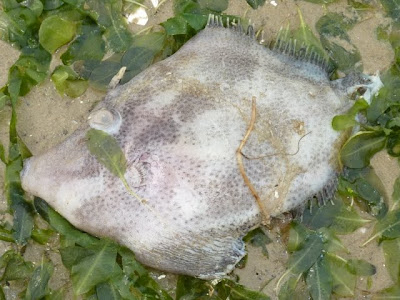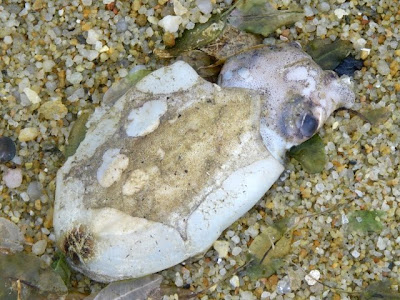Ria posted on her blog about dead fish reported on Pasir Ris beach from The Straits Times. So we thought we should go take a look since we are worried that the heavy rains may also affect the shore as well.
And indeed they were lots of dead fish! This is piled up by the cleaner and there are many many more lying all over the shore during the low tide.
Most of the dead fish are these tiger garoupas as reported in the press. They are definitely not the intertidal fish were see but are the big ones.
There are also a wide variety of other fish like this rabbitfish.
This is a dead filefish. We saw quite a number of them today too.
And even a dead flatfish was found!
More dead fish...
More dead fish...
And this one looks like the one we eat with Nasi Lemak... dead too!
While I was taking photo of this dead small fish, I did not realise that it was in the midst of being snacked upon by the anemone until I look at this photograph again.
Not only are there dead fish, we also found a couple of dead octopuses.
And also a dead cuttlefish.
Near the mangroves by the river bank, James and I were puzzled by these worm or eel looking creatures that are dead by their burrow.
Nearby there is also another dead one.
However, this bigger one seems to be not fully dead. When we put it into a pool of water, it was wriggling about weakly. I thought it was upside down until James mentioned it is its right side up!
Amazingly, this fish does not have eyes! And it has some jaws that look like it can snap hard on its prey.
When we flip over to its real underside, there is a suction-like perching appendage that seems to suggest that it is a benthic creature. All its features suggest it is some sort of a cave-like marine animal. Hmm. We have no idea what it is!
Well, the mass mortality of the fish at Pasir Ris is disturbing! According to the report, this was what it mentioned:
"The Agri-Food and Veterinary Authority (AVA) said the fish are likely to have died due to high levels of plankton, the result of heavy rain.
Decomposing plankton can lead to oxygen starvation in the water. The AVA said the fish, mostly tiger garoupas, were from nearby fish farms."
The waters we saw today were like milo-coloured in brown.
Ria shared with her that a fishermen who has been fishing for many years told her that the sea looks red and he has never seen this happened before here.
Could it be due to a red tide or also known as harmful algal bloom?
I have checked the wikipedia and it said that "a harmful algal bloom (HAB) is an algal bloom that causes negative impacts to other organisms via production of natural toxins, mechanical damage to other organisms, or by other means. HABs are often associated with large-scale marine mortality events and have been associated with various types of shellfish poisonings."
So it is possible that harmful phytoplankton such as dinoflagellates may be the culprit. But what caused the blooming of phytoplankton. My guess will be that the torrential rain has washed down a lot of agricultural nutrients from the land that led to the increase of phytoplankton. As algal bloom results in the lowering of oxygen in the sea, therefore it is possible that the fish in the fish farm died this way.
But why did the fish farm not properly dispose the dead fish but to release them all into the sea which may worsen the whole situation.
I hope all things will be back to usual soon though we all would have guessed it will take some time.
Enough of mass death, at least they were also life to neutralise the gloom and doom of the fish mortality event. It was heartening to see soldiers of fiddler crabs on the shore near the mangroves.
Among the seaweed are some other life like this hermit crab on the shell of the Tiger moon snail.
There were some people digging for worms and they left behind a big pile of dug soil. Among the mess, I noticed some weird creepy creatures in red that I have no idea what they are.
It was a big relief to know that the Haddon's carpet anemones (Stichodactyla haddoni) are still doing well, and not white and upturned like during the 2007 Chek Jawa mass mortality event. So salinity is still in control.
Another soft bodied creature that I've found is this Spiky sea pen (Scytalium sp.). No porcelain crab was found though.
The only sea cucumber I came across was this Purple sea cucumber. Well, it is always a relief that the soft bodied creatures are doing ok since they are most sensitive to extreme salinity fluctuations.
Nearing 5pm, like being synchronised by some internal alarm clock (to our own imagination), these Plain sand stars (Astropecten indicus) started to come out of the sand.
And later we saw the Biscuit sea star (Goniodiscaster scaber) which Ria found earlier on.
I was glad to have another look at this tiny Bubble shell snail (Family Haminoeidae). I hardly spot it myself in the past but saw it while staring at the seaweed.
Another mollusc that I saw on the shore is this Razor shell (Family Solenidae)! It is nice to always see it in action.
Last but not least, a stunning pink sponge to share with you all.
Well, I do hope the waters at Eastern Johor Strait will return to normal condition in the near future. Not all is lost, so there is hope for the life there.
More photos of today's trip here: http://www.flickr.com/photos/koksheng/archives/date-taken/2009/12/30/
Wednesday, December 30, 2009
Dead fish on Pasir Ris shore
Subscribe to:
Post Comments (Atom)
































.jpg)


No comments:
Post a Comment